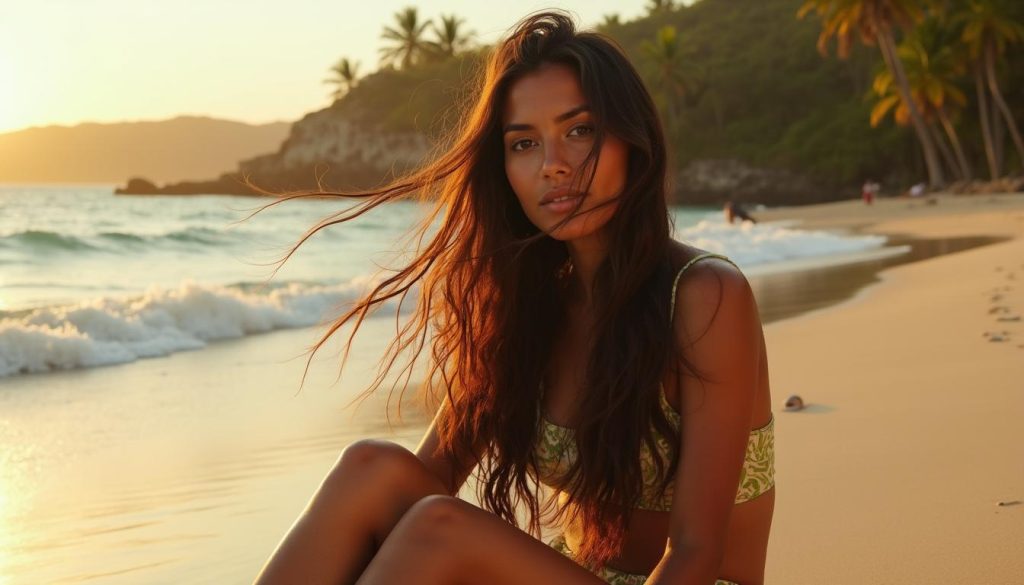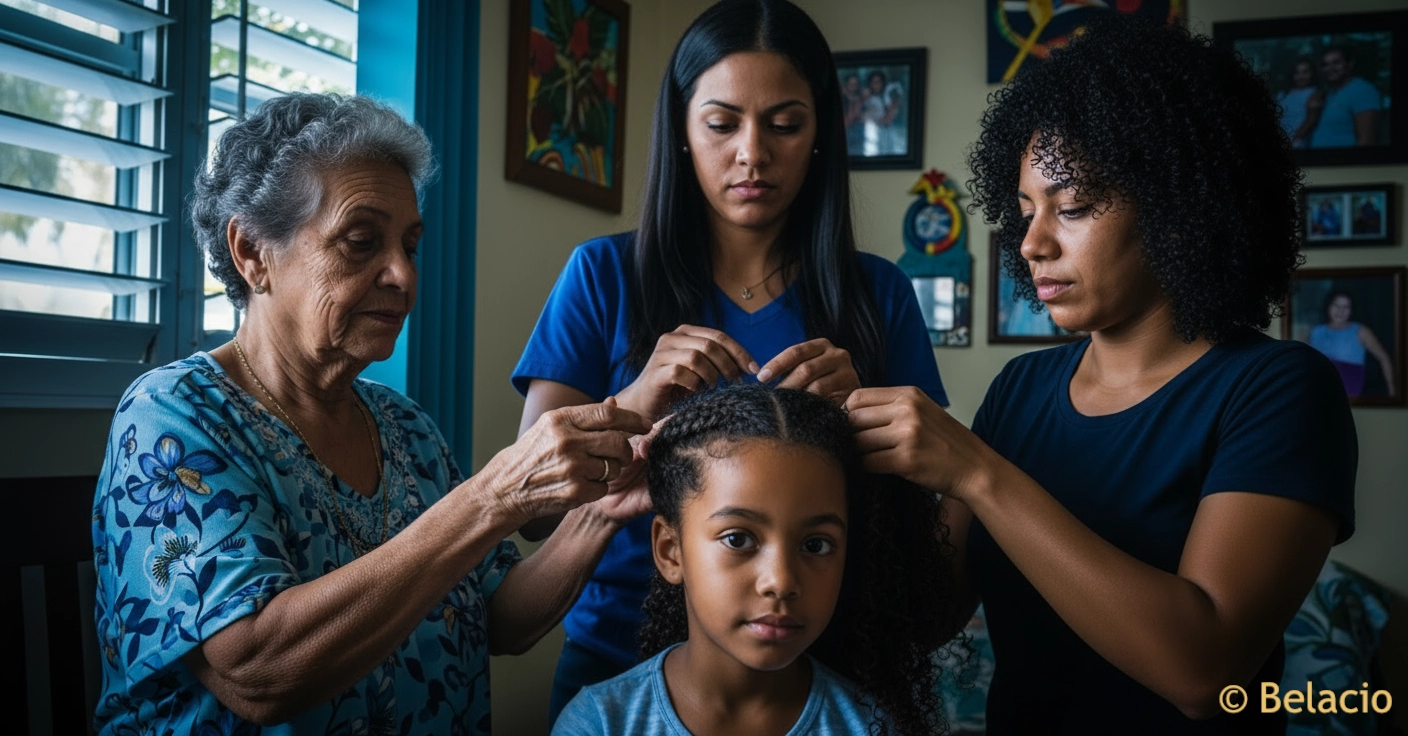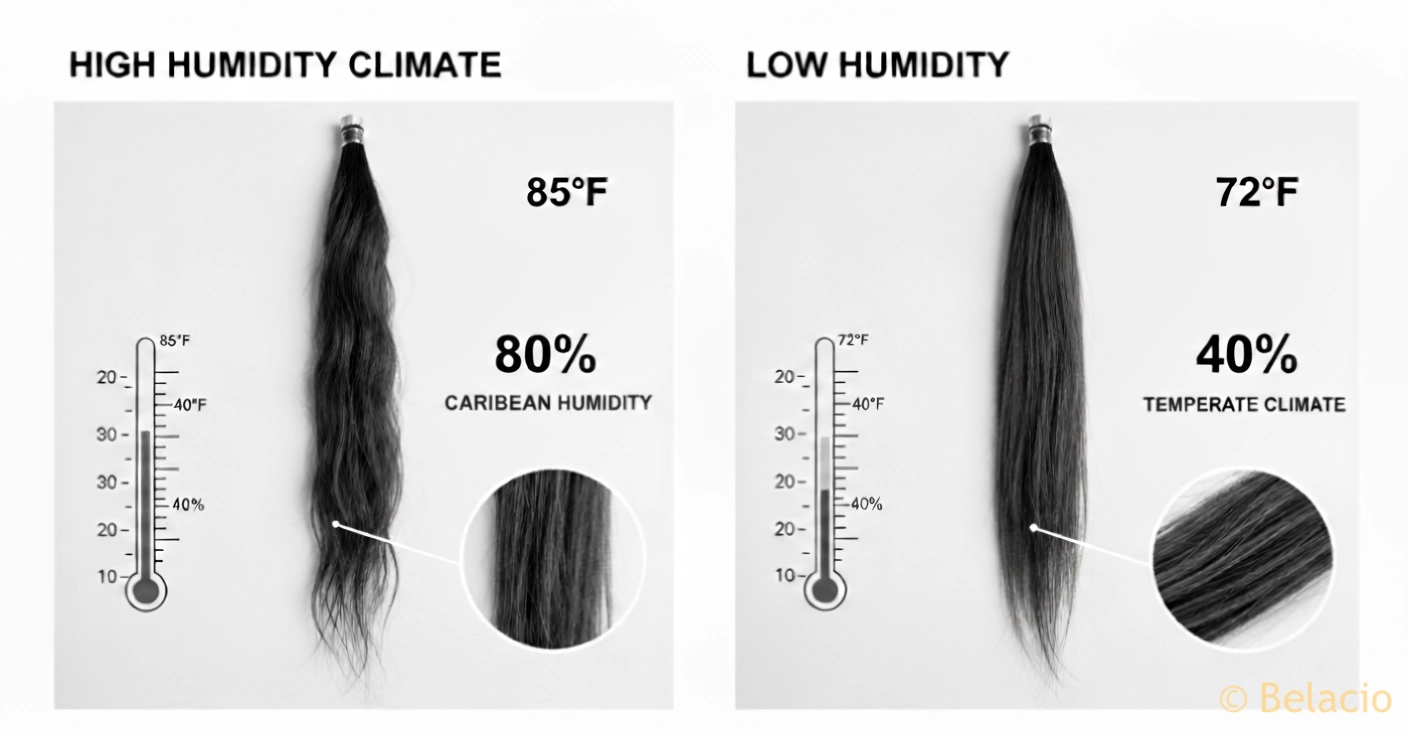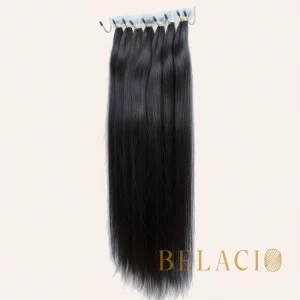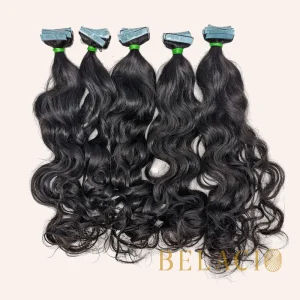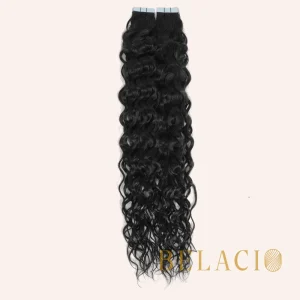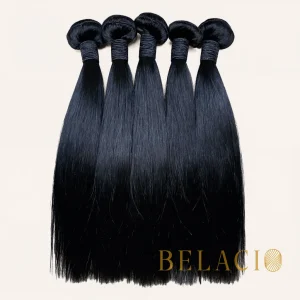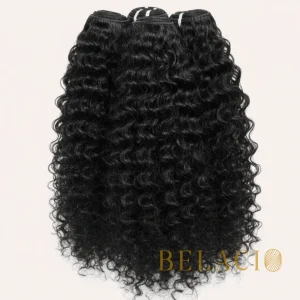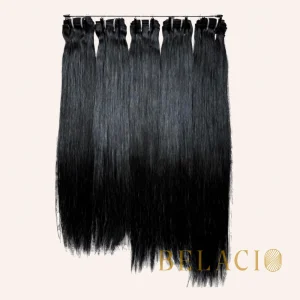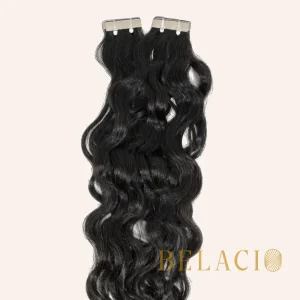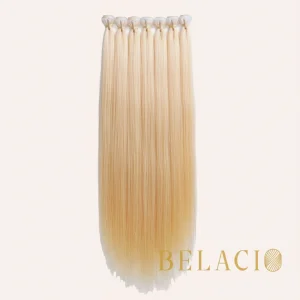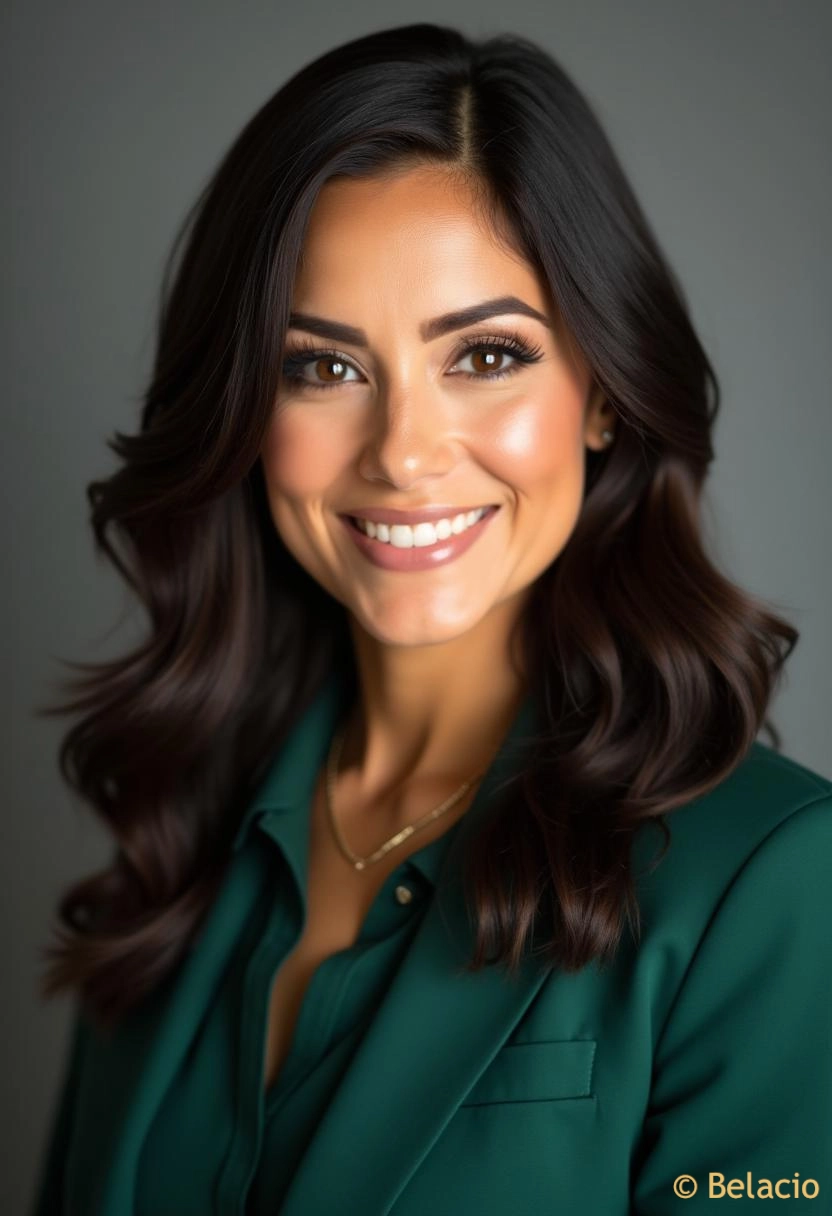Living in Puerto Rico means dealing with 75-80% average humidity year-round—a reality that makes traditional hair extension care inadequate and often frustrating. If you’re a Caribbean woman seeking beautiful, long-lasting hair that honors your cultural heritage while thriving in tropical conditions, you’re facing a unique set of challenges that mainstream beauty brands simply don’t understand.
The truth is, Puerto Rico’s climate demands specialized hair extensions and care protocols. Recent climate data shows our island experienced over 5,000 hours of dew point temperatures exceeding 74°F in 2024—conditions that cause standard extensions to frizz, tangle, and lose their luster within weeks. Meanwhile, our rich Taíno, African, and Spanish heritage creates distinct beauty traditions and hair textures that require culturally-informed solutions.
At Belacio, we’ve spent years developing climate-adapted hair extension solutions specifically for Caribbean women. This comprehensive guide combines scientific climate research with deep cultural understanding to help you achieve stunning, resilient hair that celebrates your heritage. Whether you’re in San Juan, Arecibo, or planning to expand your look to our Colombian coastal markets, this is your definitive resource for thriving with extensions in tropical paradise.
Why Caribbean Climate Demands Specialized Hair Extensions
The Caribbean’s tropical climate creates unique challenges for hair extensions that most manufacturers never consider. With Puerto Rico averaging 72-80% humidity throughout 2024, traditional hair care approaches fail dramatically in our environment.
The Science Behind Humidity and Hair
Hair is naturally porous, and in high-humidity environments, both natural hair and extensions absorb excess moisture from the air. This absorption causes the hair shaft to swell, disrupting the smooth cuticle layer that gives hair its sleek appearance. Extensions are particularly vulnerable because they lack the natural oils produced by your scalp—oils that provide some protection against moisture penetration.
Recent research on tropical climate hair care shows that:
- Hair fiber swelling increases by 34% in 80%+ humidity conditions
- Frizz formation accelerates 3x faster in tropical climates compared to temperate zones
- Extension longevity decreases by 40-60% without proper climate adaptation protocols
Puerto Rico’s Extreme Climate Reality
Our island’s 2024 climate data reveals why standard extension care fails here:
- Record-setting humidity: San Juan experienced over 5,000 hours with dew points above 74°F
- Consistent heat: Year-round temperatures between 84-89°F with no relief season
- Persistent moisture: Above-normal rainfall island-wide, creating saturated air conditions
- Wet bulb stress: Combined heat and humidity reaching near-record levels
These conditions create what trichologists call “extreme moisture stress” on hair fibers. Your extensions aren’t failing because they’re low quality—they’re failing because they weren’t designed for Caribbean reality.
The Cultural Dimension
Beyond climate science, Puerto Rican women face additional challenges. Our diverse heritage means varying hair textures within the same family. The extensions that work beautifully for your straight-haired prima may be a disaster for your naturally curly textura. Understanding both climate adaptation AND cultural hair diversity is essential for success.
Cultural Hair Traditions in Puerto Rico: From Taíno to Modern Styling
Puerto Rico’s hair culture represents one of the world’s most beautiful examples of blended heritage. With our population of 3.2 million drawing from Taíno, African, and Spanish ancestries, hair styling traditions reflect centuries of cultural evolution and adaptation.
Taíno Heritage: The Foundation
Archaeological evidence shows that Taíno women maintained elaborate hair rituals, often incorporating natural oils from tropical plants to protect against humidity and sun exposure. The Taíno tradition of straight black hair as a mark of indigenous beauty persists today, celebrated during festivals like the Festival Nacional Indígena in Jayuya.
Over 35,000 Puerto Ricans identified as having indigenous ancestry in the 2010 census, with many more carrying Taíno genetic markers through maternal lines. This heritage influences modern hair preferences toward:
- Long, sleek styles reminiscent of traditional Taíno aesthetics
- Natural oil treatments using coconut and other indigenous plants
- Protective styling during ceremonial occasions
African Heritage: Protective Traditions
The African influence brought sophisticated protective styling techniques that prove remarkably suited to Caribbean humidity. Bomba and plena music traditions showcase intricate braiding and head wrap techniques that protect natural hair while creating stunning aesthetics.
In coastal areas and communities like Loíza, traditional African-inspired practices include:
- Complex braiding patterns that last weeks in high humidity
- Head wraps (pañuelos) that protect hair while making fashion statements
- Natural hair celebrations during festivals like Festival de Santiago Apóstol
These techniques weren’t just aesthetic—they were climate-adapted survival strategies that modern extension wearers can learn from.
Spanish Colonial Influence: European Aesthetics
Spanish colonization introduced European beauty standards that emphasized long, flowing hair and elaborate updos. This influence appears in:
- Religious and ceremonial styling for Catholic festivals and celebrations
- Formal occasion aesthetics still seen in quinceañeras and weddings
- Professional styling techniques that formed the basis of modern salon culture
Modern Synthesis: Contemporary Puerto Rican Beauty
Today’s Puerto Rican hair culture beautifully synthesizes all three traditions. Walk through any San Juan neighborhood and you’ll see:
- Versatility as identity: Women switch between bone-straight looks and full curly styles weekly
- Celebration of texture diversity: Natural curls, relaxed styles, and extensions all embraced
- Cultural pride through hair: Styles that consciously honor African, Taíno, or Spanish heritage during cultural events
This cultural complexity means successful extensions must be versatile enough to support your full range of ancestral expression.
Types of Hair Extensions Perfect for Caribbean Climate
Not all hair extensions can survive Caribbean conditions. After extensive testing in Puerto Rico’s extreme humidity, we’ve identified the specific types and treatments that thrive in tropical climates.
Remy Hair Extensions: The Gold Standard
Remy hair extensions represent the premium choice for Caribbean conditions because the cuticles remain intact and aligned in their natural direction. This structure provides superior resistance to humidity-induced frizz and tangling.
Climate Performance Advantages:
- Cuticle alignment prevents moisture from causing reverse-direction friction
- Natural oil retention maintains smoothness in high humidity
- Color stability withstands intense Caribbean sun exposure
- Longevity of 8-12 months even in tropical conditions
Best Remy Options for Puerto Rico:
- Malaysian Remy: Naturally thick and coarse, ideal for Caribbean hair textures
- Indian Remy: Versatile texture that blends well with mixed-heritage hair
- Brazilian Remy: Silky smooth with natural movement, perfect for formal occasions
Virgin Hair Extensions: Ultimate Performance
Virgin hair extensions have never been chemically processed, making them the most resilient option for extreme climate conditions. In our Caribbean testing, virgin hair consistently outperformed all other types.
Tropical Climate Benefits:
- Chemical-free structure resists humidity damage
- Natural elasticity prevents breakage from moisture expansion
- Unprocessed cuticles provide maximum frizz resistance
- Customization potential for color-treating to match your unique heritage blend
Tape-In Extensions: Climate-Adapted Convenience
Tape-in extensions have gained massive popularity among Puerto Rican women because they lay flat against the head—crucial for our hot, humid conditions where heavy hair becomes uncomfortable.
Why They Work in Caribbean Climate:
- Lightweight application prevents overheating
- Flat profile allows for updos during humid weather
- 6-8 week lifespan accommodates frequent tropical weather changes
- Reusable adhesive designed for high-humidity conditions
Many San Juan salons now specialize in “extensiones de cinta” (tape-ins) because clients can maintain styles during our intense summer months and still put hair up when dancing bomba or plena.
Climate-Specific Extension Textures
Caribbean testing reveals which textures perform best in our conditions:
Superior in High Humidity:
- Body wave: Natural movement disguises humidity-induced texture changes
- Loose curly: Works WITH Caribbean humidity instead of fighting it
- Kinky curly: Ideal for blending with Afro-Caribbean natural textures
Challenging in Tropical Conditions:
- Bone straight: Requires intensive daily maintenance to combat frizz
- Tight curls: Can become matted in extreme humidity
- Heavily processed: Chemical damage accelerates in hot, moist conditions
Professional Installation Considerations
In Caribbean climates, installation method dramatically affects longevity:
- Sew-in weaves (extensiones cosidas): Excellent for humidity, allow natural hair to breathe
- Clip-ins: Perfect for temporary styling, easy removal during beach days
- Fusion methods: Require humidity-resistant bonding agents
- Crochet techniques: Increasingly popular for protective styling in tropical weather
Extensiones de Cabello Humano: Terminología en Español para Puerto Rico
Understanding proper Spanish terminology is essential for communicating about hair extensions in Puerto Rico. Our bilingual market uses specific terms that differ from other Spanish-speaking countries.
Términos Básicos (Basic Terms)
Extensiones de cabello / Extensiones de pelo = Hair extensions (both terms acceptable)
Cabello humano / Pelo humano = Human hair
Cabello virgen = Virgin hair (never chemically processed)
Pelo Remy = Remy hair (cuticles aligned, premium quality)
Tipos de Instalación (Installation Methods)
Extensiones cosidas = Sew-in extensions/weaves
Extensiones de clip = Clip-in extensions
Extensiones de cinta / Tape-ins = Tape-in extensions
Extensiones pegadas = Glue-in extensions
Entretejido = Another term for weave
Trenzas con extensiones = Braided extensions
Texturas y Calidad (Textures and Quality)
Lacio = Straight
Ondulado = Wavy
Rizado = Curly
Cabello que se puede decolorar = Hair that can be bleached (often to #613 blonde)
Doble seleccionado = Double drawn (uniform length)
Cabello hindú / Cabello de la India = Indian hair
Cuidado y Mantenimiento (Care and Maintenance)
Champú sin sulfato = Sulfate-free shampoo
Desenredante = Detangler
Acondicionador sin enjuague = Leave-in conditioner
Cepillo para extensiones = Extension brush
Productos anti-humedad = Anti-humidity products
Términos del Salón (Salon Terms)
Extensionista = Extension specialist
Instalación profesional = Professional installation
Mantenimiento de extensiones = Extension maintenance
Retoque de raíces = Root touch-up
Blowout dominicano = Dominican blowout (popular in PR)
Expresiones Culturales (Cultural Expressions)
“Pelo malo” = Derogatory term for kinky hair (avoid using)
“Pelo bueno” = Problematic term for straighter hair (also avoid)
“Cabello natural” = Natural hair (preferred, positive term)
“Pelo postizo” = Any type of artificial hair attachment
“Melena” = Mane/flowing hair (poetic term)
Frases Útiles para el Cliente (Useful Customer Phrases)
“¿Se puede teñir este cabello?” = “Can this hair be dyed?”
“¿Cuánto dura la instalación?” = “How long does the installation last?”
“¿Resiste la humedad boricua?” = “Does it resist Puerto Rican humidity?”
“¿Viene con garantía?” = “Does it come with a guarantee?”
Professional Installation Services in Puerto Rico
Professional installation makes the difference between extensions that last months versus weeks in Caribbean conditions. Puerto Rico’s salon industry has developed specialized techniques for our unique climate challenges.
Finding Qualified Professionals
Certified Extension Specialists:
Look for professionals trained in tropical climate techniques. Many San Juan salons offer “certificación en extensiones para clima tropical” (tropical climate extension certification).
Regional Expertise:
- San Juan Metro: Highest concentration of specialists, latest techniques
- Bayamón/Carolina: Growing expertise, often more affordable
- Ponce/South Coast: Specialists understand extreme heat and humidity
- West Coast (Mayagüez/Aguadilla): Beach-focused protective styling experts
Installation Methods for Caribbean Climate
Sew-In Weaves (Extensiones Cosidas)
- Price Range: $150-400 depending on hair quality and length
- Duration: 6-8 weeks in tropical conditions
- Best For: Long-term wear, swimming, active lifestyles
- Humidity Advantage: Cornrow base allows scalp to breathe
Tape-In Installation
- Price Range: $200-500 including hair
- Duration: 6-8 weeks with professional retaping
- Best For: Quick application, flat profile for updos
- Climate Benefit: Lightweight, doesn’t overheat in humidity
Fusion/Keratin Bonding
- Price Range: $300-600 per application
- Duration: 3-4 months with proper care
- Best For: Natural movement, individual strand application
- Tropical Consideration: Requires humidity-resistant bonding agents
Salon Quality Standards
Questions to Ask Your Stylist:
- Experience with Caribbean climate challenges?
- Availability of humidity-resistant products?
- Post-installation care education?
- Touch-up and maintenance scheduling?
- Guarantee policies for climate-related issues?
Red Flags:
- Salons that don’t discuss climate considerations
- No experience with your specific hair texture
- Pressure to use synthetic over human hair
- No follow-up maintenance planning
Maintenance Scheduling
Caribbean conditions require more frequent professional maintenance:
- 2 weeks: Humidity assessment and product recommendations
- 4 weeks: Mid-point check, deep conditioning treatment
- 6-8 weeks: Full maintenance, possible reinstallation
- Monthly: Professional deep conditioning in summer months
Belacio Hair: Caribbean Climate Expertise and Quality Standards
At Belacio, we didn’t just enter the hair extension market—we revolutionized it for Caribbean women. Based in Arecibo, Puerto Rico, we understand firsthand the unique challenges our climate presents.
Our Caribbean Specialization
Founded in Puerto Rico: Our team experiences 75-80% humidity daily, giving us unmatched insight into tropical hair challenges.
Climate Testing: Every product in our line undergoes rigorous testing in Puerto Rico’s extreme humidity before reaching customers.
Cultural Understanding: Our sourcing reflects Puerto Rico’s diverse heritage—from silky straight options honoring Spanish ancestry to kinky curly selections celebrating African roots.
Maintenance Protocol for Caribbean Hair Extensions
Proper maintenance is crucial for extension longevity in Caribbean conditions. Our scientific approach combines humidity protection with cultural hair care wisdom.
The Belacio Caribbean Care System
Step 1: Daily Humidity Protection
- Morning: Apply leave-in conditioner with UV protection
- Pre-styling: Use anti-humidity serum on mid-lengths to ends
- Evening: Light oil treatment on tips to prevent dryness
Step 2: Weekly Deep Care Ritual
- Gentle cleansing: Sulfate-free shampoo, focus on scalp
- Deep conditioning: 15-minute treatment with tropical botanicals
- Air drying: Avoid heat when possible; humidity will air-dry faster
Step 3: Monthly Professional Treatment
- Humidity assessment: Professional evaluation of extension condition
- Deep protein treatment: Restore strength after tropical weather exposure
- Bond reinforcement: For fusion and tape-in methods
Products That Work in Caribbean Climate
Humidity Blockers:
- Coconut oil-based serums (natural to Caribbean culture)
- Leave-in conditioners with marine botanicals
- UV protection sprays for sun exposure
Deep Treatment Options:
- Aloe vera masks: Traditional Caribbean remedy for hair repair
- Shea butter treatments: African heritage ingredient, excellent for humidity
- Argan oil: Light enough for tropical conditions
Lifestyle Adaptations
Beach and Pool Protocol:
- Pre-swim: Saturate with fresh water and apply protective oil
- Post-swim: Immediate fresh water rinse and gentle detangling
- Salt/chlorine neutralizer: Essential for Caribbean beach culture
Exercise and Dance:
- Protective styles: Braids or buns for bomba and salsa dancing
- Post-workout care: Gentle cleansing after Caribbean heat activities
- Moisture balance: Replace lost hydration from sweating
Conclusion: Embracing Your Heritage Through Climate-Smart Beauty
Your journey to beautiful, long-lasting hair extensions in Puerto Rico doesn’t have to be a struggle against humidity and cultural misunderstanding. By choosing climate-adapted solutions and culturally-informed approaches, you can achieve stunning results that honor your Taíno, African, and Spanish heritage while thriving in tropical paradise.
The Caribbean hair extension market is experiencing unprecedented growth—7.6% annually—driven by women like you who refuse to settle for products that don’t understand our unique needs. At Belacio, we’re proud to lead this revolution with scientific approaches, cultural sensitivity, and unmatched local expertise.
Whether you’re preparing for a quinceañera in San Juan, a beach wedding in Rincon, or simply want to feel confident in your daily beauty routine, the right extensions make all the difference. Don’t let another humid day compromise your hair goals.
Ready to transform your look with extensions designed for Caribbean reality?
Contact Belacio Hair today:
[email protected]
+1-787-671-7122
belacio.hair
Serving Puerto Rico and expanding to Colombian Caribbean coast
Experience the difference that true Caribbean expertise makes.
Frequently Asked Questions
Climate-Related Questions
Q: Will hair extensions survive Puerto Rico’s humidity?
A: Yes, with proper selection and care. Remy and virgin hair extensions perform best in our 75-80% humidity. Avoid heavily processed hair that’s more vulnerable to moisture damage.
Q: How long do extensions last in Caribbean climate?
A: High-quality human hair extensions last 6-8 months with proper care in tropical conditions. Synthetic extensions typically last only 2-3 months due to humidity damage.
Q: Can I swim with hair extensions in Puerto Rico?
A: Yes, but preparation is key. Saturate hair with fresh water before entering pools or ocean, and rinse immediately after swimming to remove salt and chlorine.
Q: What’s the best texture for Caribbean humidity?
A: Body wave and loose curly textures work WITH humidity instead of fighting it. Bone straight requires more maintenance but is possible with proper products.
Cultural and Practical Questions
Q: Do extensions work with Afro-Caribbean hair textures?
A: Absolutely. Kinky curly and coarse textures blend beautifully with natural Afro-Caribbean hair. Many Puerto Rican women use extensions for protective styling.
Q: Are there extensions that honor Puerto Rican heritage?
A: Yes. We offer textures and colors that celebrate Taíno, African, and Spanish ancestries. Our specialists help match extensions to your cultural aesthetic preferences.
Q: Can I get extensions installed in Spanish?
A: Of course. Most Puerto Rican salons operate in Spanish, and our customer service team is fully bilingual. We understand Caribbean Spanish terminology.
Q: What about maintenance during hurricane season?
A: Protective styling is crucial. Braids, buns, and headwraps protect extensions during extreme weather. Keep deep conditioning treatments on hand for post-storm care.

